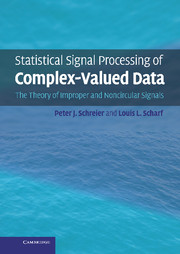Book contents
- Frontmatter
- Contents
- Preface
- Notation
- Part I Introduction
- 1 The origins and uses of complex signals
- 2 Introduction to complex random vectors and processes
- Part II Complex random vectors
- Part III Complex random processes
- Appendix 1 Rudiments of matrix analysis
- Appendix 2 Complex differential calculus (Wirtinger calculus)
- Appendix 3 Introduction to majorization
- References
- Index
2 - Introduction to complex random vectors and processes
from Part I - Introduction
Published online by Cambridge University Press: 25 January 2011
- Frontmatter
- Contents
- Preface
- Notation
- Part I Introduction
- 1 The origins and uses of complex signals
- 2 Introduction to complex random vectors and processes
- Part II Complex random vectors
- Part III Complex random processes
- Appendix 1 Rudiments of matrix analysis
- Appendix 2 Complex differential calculus (Wirtinger calculus)
- Appendix 3 Introduction to majorization
- References
- Index
Summary
This chapter lays the foundation for the remainder of the book by introducing key concepts and definitions for complex random vectors and processes. The structure of this chapter is as follows.
In Section 2.1, we relate descriptions of complex random vectors to the corresponding descriptions in terms of their real and imaginary parts. We will see that operations that are linear when applied to real and imaginary parts generally become widely linear (i.e., linear–conjugate-linear) when applied to complex vectors. We introduce a matrix algebra that enables a convenient description of these widely linear transformations.
Section 2.2 introduces a complete second-order statistical characterization of complex random vectors. The key finding is that the information in the standard, Hermitian, covariance matrix must be complemented by a second, complementary, covariance matrix. We establish the conditions that a pair of Hermitian and complementary covariance matrices must satisfy, and show what role the complementary covariance matrix plays in power and entropy.
In Section 2.3, we explain that probability distributions and densities for complex random vectors must be interpreted as joint distributions and densities of their real and imaginary parts. We present two important distributions: the complex multivariate Gaussian distribution and its generalization, the complex multivariate elliptical distribution. These distributions depend both on the Hermitian covariance matrix and on the complementary covariance matrix, and their well-known versions are obtained for the zero complementary covariance matrix.
- Type
- Chapter
- Information
- Statistical Signal Processing of Complex-Valued DataThe Theory of Improper and Noncircular Signals, pp. 30 - 58Publisher: Cambridge University PressPrint publication year: 2010



